My favourite pastime while riding public transport in Kerala is listening to conversations of co-passengers especially when they are talking into their mobile phones. Then, this is like saying the bomber decides to die as his ticking torso goes off – there is not much choice here as they practically declaim into their devices. And this isn’t due to the engine din or network issues: my fellow folks love to be heard and to display publicly that somebody is actually listening to them.
“I’m on my way to Angamaly,” went the guy sitting behind me. “Didn’t you know that so-and-so chettan has cataract and the surgery is scheduled for today?”
He had me worried: we were on a bus heading the other way to Alleppey. I turned and looked at him. He winked at me and smiled, assured me that he knew he was on the ‘wrong’ bus.
“I am going for the boat race,” he said to me. “But what do they know!”
I too was on my way to the to the Punnamada Lake in Alleppey where the Nehru Trophy Boat Race is held each year. But I continued to be worried for him: before hanging up he promised the they on the other end that he would return after the race with grocery and proceed to clean up the clogged bathroom drain followed by digging a new hole to dispose trash.
Men in blue, women too
Vallamkali, vallamkali, vallamkaliye
Punnamada kayalile olamthulliye
Vallamkali pattumayi muthukkudayayi
Kayal maaril niranallo chundan vallangal
(Behold the wonderful boats
Breaking tide, setting pace,
With songs and embellishments
Along the Punnamada Lake for the race.)
Vanchippattu, or boat songs, a regular staple of waterfront celebrations, toddy shops and boat races filled the venue, echoed over the water between the starting and finishing points. This particular one, a personal favourite, was a hit number belted out by a noted comedian of Malayalam cinema, Kalabhavan Mani, who died under mysterious circumstances not very long ago. The immensely gifted actor loved to hang out with fisherfolk, on their boats, fishing, and drinking, er, like a fish. The mellifluous rendering by Mani transported the ripples from the water to the air. Trying hard to rend it – and succeeding through tympanum cracks – were the vuvuzela blares. Free newspapers distributed at the venue (‘Take it, it’s quite sunny out there,’ one vendor said shoving a leading daily into my hand.) were shredded and tossed into the air. Hundreds of empty plastic water bottles bongo-beat in unison breaking only for the occasional lead call:
‘Aaarppoo…’ followed by the chorus: ‘Hirro….Hirro…Hirro.’
Unlike the previous editions I attended, this time around there was a theme even – blue. The idea was to create awareness of the ecological damage inflicted upon the lake and its surrounding areas – the famed Vembanad backwaters – by the very houseboats that take tourists to revel in the scenic glory. Besides regular tourism aftermaths like mounting plastic and other waste, there were illegal constructions blatantly flouting coastal regulations reifying the threat perception. A bunch of kids from the NSS unit of a local college tried to drive home the point by making passers-by jot their vision to #SaveVembanad to be hung on a wish tree. My two cents were to ban bottled water from houseboats and supply guaranteed RO water instead. A suggestion repeatedly shot down by houseboat operators each time I have been on one. ‘The tourists themselves insist on bottled water,’ they countered.
Sometime ago at a Kovalam hotel I was nearly thrown out for insisting on non-bottled water. It was my right, I maintained. But not really, was the gist of the lesson I learnt then, when the margins to be earned on a litre was five to seven rupees.
Gabriel – the dashing angel
Bibin stood in the scorching sun shaded by an oversized umbrella carefully noting heats timings. At the end of every run he would report it to somebody over the phone. ‘Punter,’ I decided before approaching him. It was time to recoup some money I lost on cockfighting in Chhattisgarh. (It happened a few years ago but I still hadn’t told my mom about it. And I could only if I got some of it back.) My hopes were dashed when it turned out that he was only helping his boss keep a tab on competition. The boss, Blesson, owned Gabriel, a snakeboat which made its competitive debut just the previous year with an astounding second place. They had, of course, set their sights on improving their lot this year. There was a fracas in the heats Gabriel had drawn lots to enter causing an inordinate delay. Reports from the starting point – I, along with thousands of others in the pavilion and one in the water (‘The fourth umpire’ – see photo) preferred to be at the finishing point to record photo finishes – pointed to umpires huffing and puffing trying to sort the melee.
Panting problems are nothing new in the world of boat racing in Kerala. Rules continue to be written to address issues and rewritten once modes of circumvention are discovered. One club which sort of approached an unbeatable reputation was found to be employing the services of ex-servicemen; up to 80 per cent of their oarsmen – which meant around 80 members – were ex-Army. The sturdy physique, and above all, the discipline, helped. Once the strategy came to light, competing clubs jumped in upping the ante – enlisting armed forces personnel who were on leave. (And there were plenty this time of the year which was annual vacation in the Gulf countries: they came to visit their relatively better-off brethren or friends.) Instead of allowing each team to become little battalions, the governing body stepped in and limited the services participation to not more than 20 per cent.
The issue was sorted and Gabriel was back in the fray. While traditionally the final never went beyond four or five PM, this time it neared seven PM before the final whistle blew. Blesson’s father, the dashing Achankunju, who was the chief oarsman, was a picture of furious focus. The rhythm drums beat to a mechanical timing rendering clockwork unison to a couple of hundred of limbs which thrashed the water to nary a froth. Dreaded for professionalism and precision, the United Boat Club of Kainakary, was the one to fear. Galleries lit up with mobile phone camera flashlights, aerial cameras hovered close to the water, a few onlookers jumped into the water to view the finish with their own eyes, the commentator became incomprehensible, and all the helmsmen leaned forward as they crossed the finishing line.
Bibin leapt up with a guttural shriek.
League-style racing – up next year?
Unlike some of the new-fangled fishing vessels even some houseboats, the snakeboats can never be of fibre. Made of wood, by traditional craftsmen, it takes at least a year to construct one, and anywhere up to one crore – ten million – rupees. Its annual maintenance itself, involving fish oil, for example, costs in millions. Then comes the practice for the racing season. An owner pays each rower fair wages for each day of practice which goes on for a month. This is besides the food and in-between nourishments. For every day – three weeks in case of Gabriel – Blesson spent close to a lakh, or hundred thousand rupees!
Coupled with the escalating costs as well as the mounting popularity of the event especially among youngsters, plans have been drawn to conduct boat races along the lines of football and cricket championship leagues. The proposed KBL – Kerala boat race league – will be held over two months spanning venues in four districts beginning with the Nehru trophy race on the second Saturday of August. The organisers hold that this can be a reality from next year itself – if all goes well.
Everything going well in Kerala means politicking taking a backseat.
Or drowned by calls of ‘Aarppoo.’
Followed by ‘Hirro’ chorus.
(Repeat.)


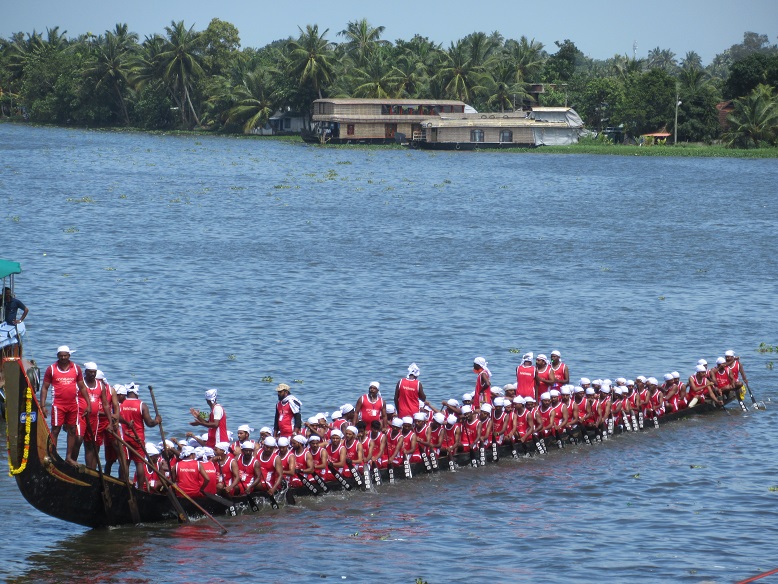
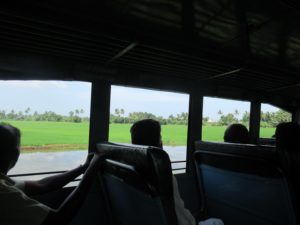
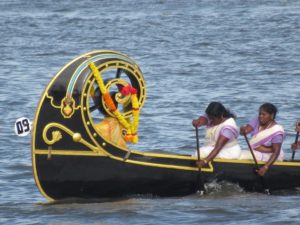
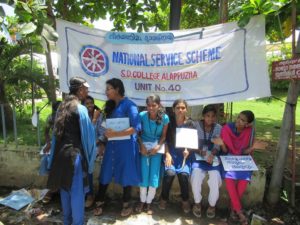
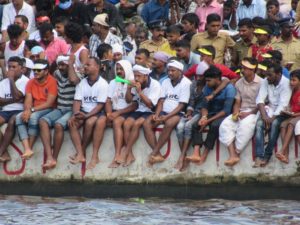
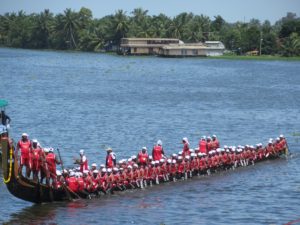
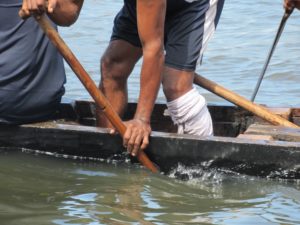
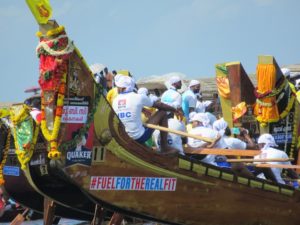
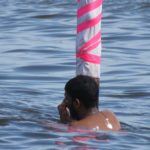









Wow…. Such a good description of race. I always wanted to see it live.
Don’t worry, its just getting bigger every year.
Nice post….very informative.Kerala is famous for vallamkali & it’s more attractive also.
Keep writing
Sure, will do. Thank you.
VERY GOOD
its great information about race. south India “god’s own country”. thanks for good bolg
Glad you like the blog :))
That looks fun! I might have to practice swimming first as I’m not very good at it. 🙂
Or you can just pick a team to cheer )
Snakeboat racing is amazing game i live its. thanks for great article
You are welcome. I am glad you liked the article.
“The world’s largest teamsport” you right the bloger. share more info about that sport with photos. my dream to visit there
You should. Its quite fascinating.
Great Post!! I like the adventure activities. This “snake-boat racing” is amazing. I love your blog.
Thank you, Mr Singh! It is mass adrenaline.
Amazing information about snakeboat racing, I thought next time I will be surely see that live.